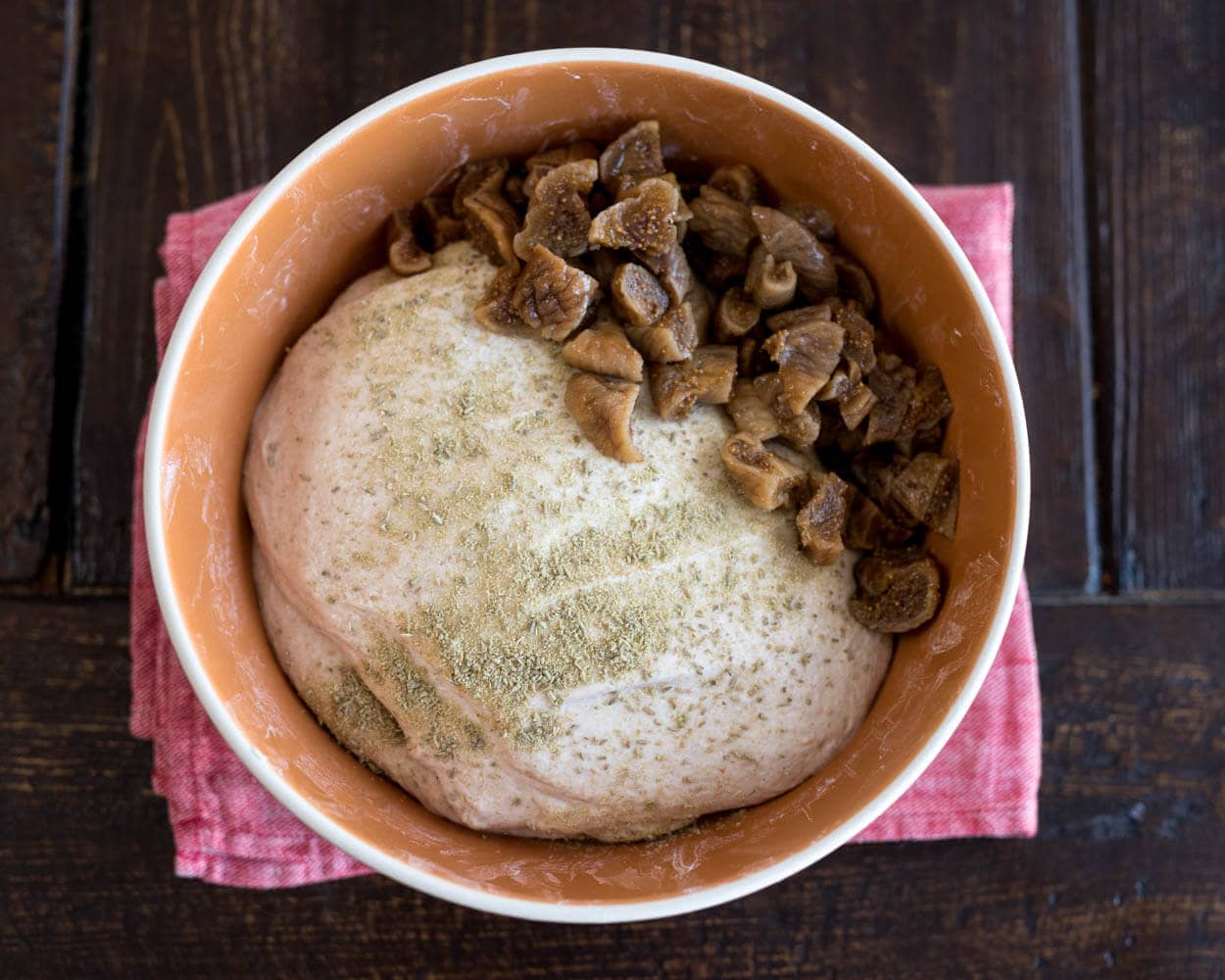Understanding and working in baker’s percentages, also known as baker’s math, is a key skill for the home and professional baker alike.
If you’ve ever wanted to scale up or down a bread recipe, baker’s percentages and this page will help you. If you’ve ever wanted to understand all those percentages and prefermented flour labels in my posts and bread books, this post will help you do that, too. This introduction to baker’s percentages is a place to dig into that not-so-scary math behind baking formulas.
What Are Baker’s Percentages?
Baker’s percentages, also known as baker’s math or formula percentage, allow a baker to quickly scale up and down recipes, read formulas (recipes), and immediately understand the type of bread it represents and a way to add and remove ingredients without affecting the entire recipe.
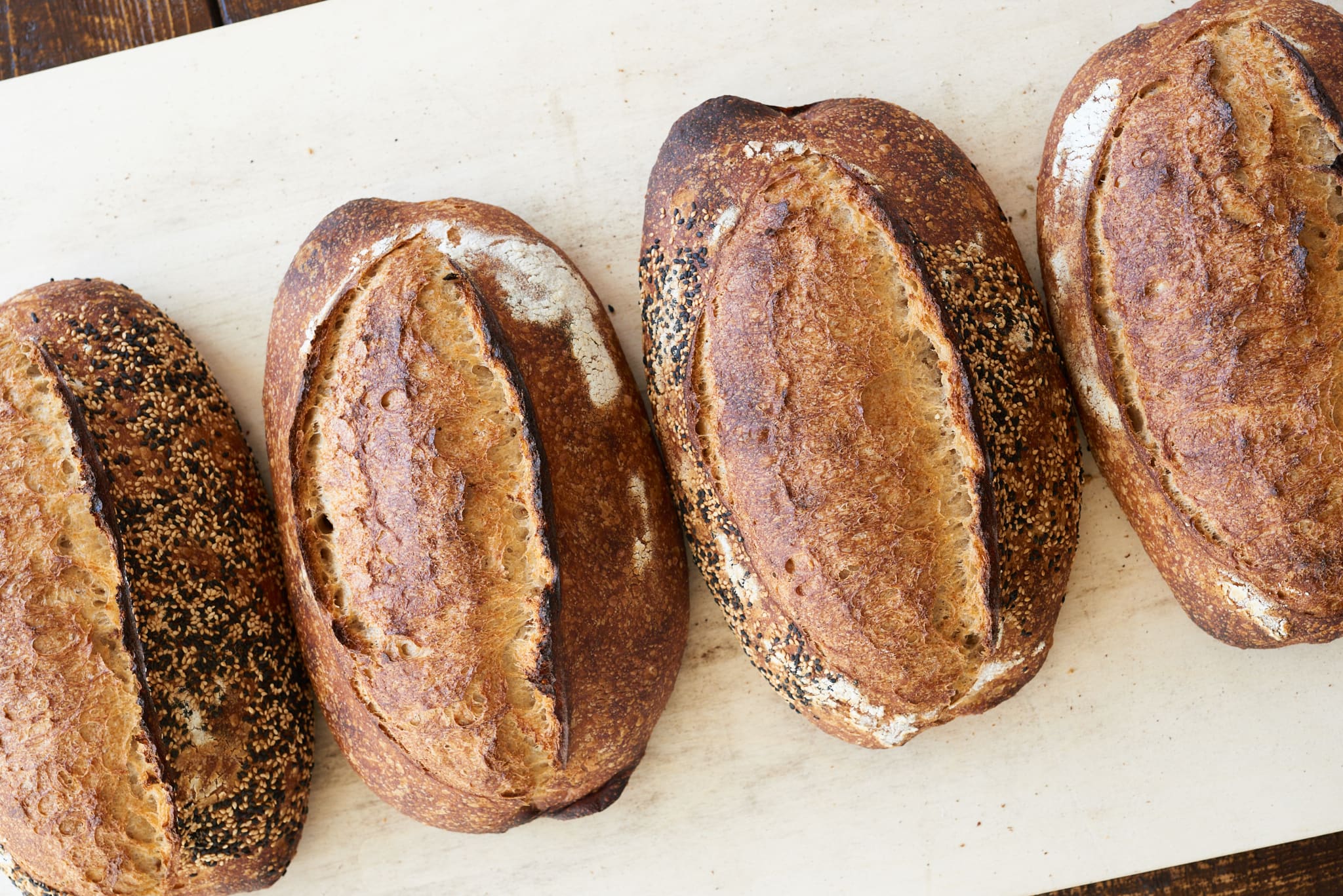
Why Use Baker’s Percentages?
The cornerstone of using baker’s percentages is that we weigh each ingredient for accuracy (you are weighing, right?), and their weight is related to the total flour weight in a recipe. This means the water, salt, preferment, nuts—everything—is a percentage of the total flour weight.
And because we keep flour at the center of everything, it gives us a starting place from which to compare everything. Instead of ingredients as percentages with respect to everything else, they’re with respect to flour only. In this way, when we see a dough hydration of 80%, we instinctively know it will likely be a pretty wet dough[footnote]Ok, I know hydration is very respective of the flour you’re using. Still, generally, 80% hydration is considered moderately high by most standards.[/footnote].
With baker’s percentages, you can:
- quickly scale up and down a recipe
- assess a recipe immediately and determine what the end bread might be like when baked (further, it helps us spot gross errors at the formula-creation level)
- communicate with other bakers in a standard format to quickly share formulas
- add, remove, or change ingredient percentages without affecting the entire formula
First, let’s go through a simple calculation to set the stage. A nice stage. A gentle stage. A stage where math is our friend.
The First Thing To Know About Baker’s Percentages
Perhaps the most confusing part about baker’s percentages can be removed by understanding this single statement:
If you sum all the percentages for all the ingredients in a formula, it will be OVER 100%.
Typically, when dealing with percentages in other areas of life, all the items add up and neatly sum to 100%, or the percentages describe the portion of a whole (e.g., 50% of the pizza is cheese).
With baker’s percentages, however, percentages are used to serve as a reference point relative to the main ingredient: flour (which is always 100% of the recipe). This lets us quickly see how much of an ingredient is in the recipe relative to the flour.
Let’s look at how you can calculate the percentage of an ingredient now that we know flour is always pegged to 100%.
Calculating The Baker’s Percentage of a Single Ingredient
Here is how you calculate the baker’s percentage for any single ingredient in a bread formula:

And that’s it! If you want to know what the hydration of a recipe is (i.e., the baker’s percentage of the water), just take the total weight of the water, divide it by the total weight of the flour, and multiply it by 100. That’ll give you the hydration percentage. And you can do this with any ingredient in the recipe: mix-ins, butter, sugar, oil, etc.
Next, let’s work through an example.
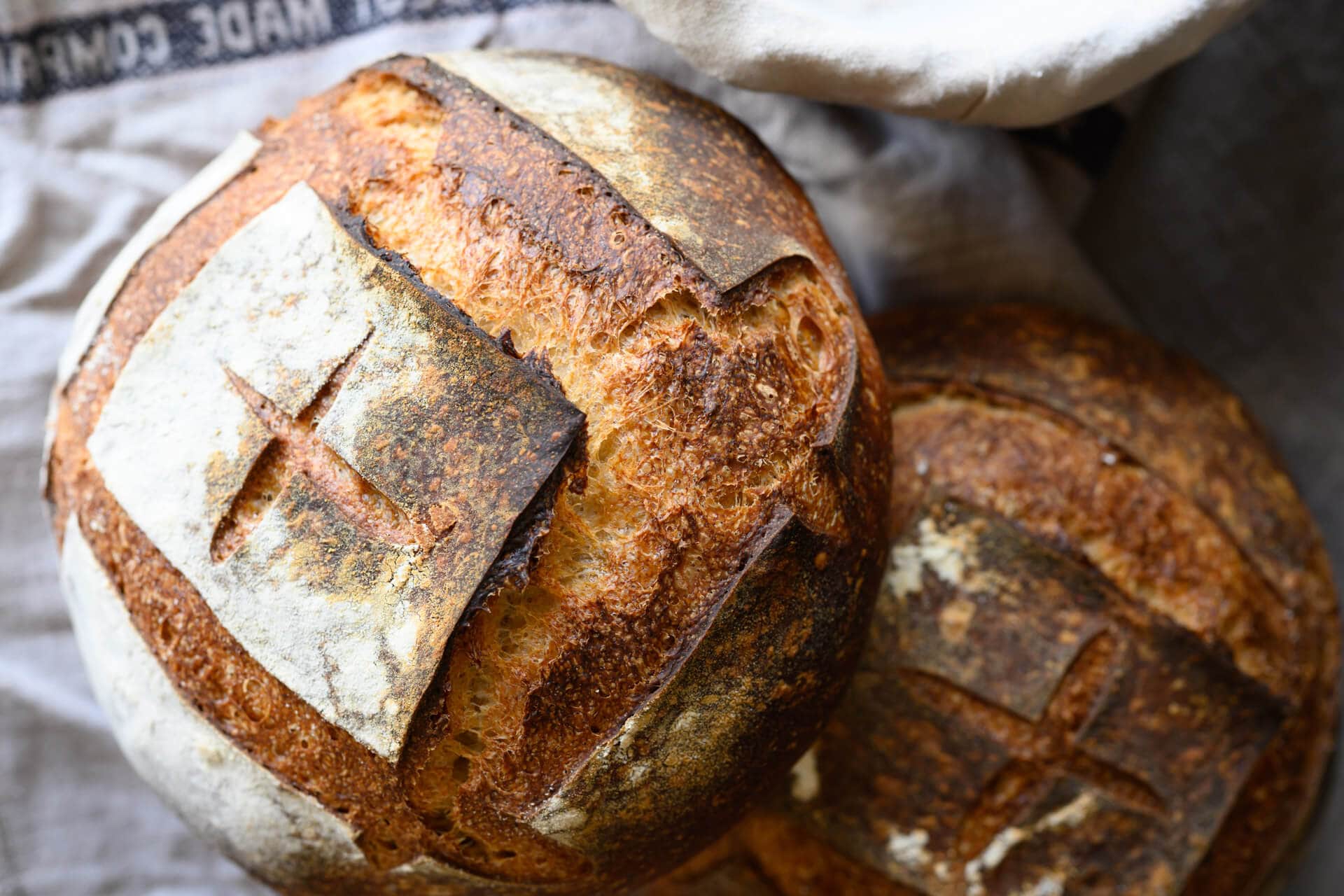
My Spreadsheets Do All The Calculations For Me
While learning baker’s percentages and math is incredibly useful, I rely on my spreadsheets to do all the work. TPL Members have access to my baking spreadsheet suite, making creating and editing bread formulas much easier. In other words, the spreadsheets do all the heavy lifting.
A Baker’s Percentage Example
Now that we know how to calculate the baker’s percentage for a single ingredient, we apply this to all the ingredients in a recipe to fill out the total formula.
Let’s use my Simple Weekend Sourdough Bread as an example to work through. Below is a table you’ll typically see here called the Total Formula table; it shows the total weight for each ingredient and its corresponding baker’s percentage.
In the table below, you’ll see some typical percentages: the flour adds up to 100% (high protein bread flour at 80% and whole wheat flour at 20%), there’s water (usually 60% – 100%), some measure of salt (typically 1.8% – 2.3%), and some preferment percentage. For weights, I don’t often include sub-gram weights (I round everything up) since most home bakers do not have scales that measure to this precision, and it’s not necessary. I included those here, though, so the numbers work out precisely.
Total Formula
| Weight | Ingredient | Baker’s Percentage |
|---|---|---|
| 805.8g | High protein bread flour, malted | 80.00% |
| 201.5g | Whole wheat flour | 20.00% |
| 765.5g | Water | 76.00% |
| 19.1g | Salt | 1.90% |
| 8.1g | Sourdough starter | 0.80% |
A few important things to note:
- if you add all the flour percentages, you’ll get 100% (80% + 20%)—and this is always true with baker’s percentages: the total flour always adds up to 100%
- if you add all the percentages, you’ll get more than 100%[footnote]This is because all the ingredients are with respect to the flour weight—a single ingredient—rather than with respect to the weight of all the ingredients.[/footnote]
In addition to the total formula we also sometimes have a preferment such as a levain. Let’s look at that table.
Levain (Preferment)
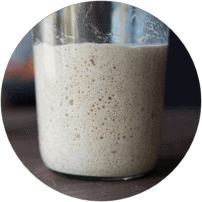
Many bakes here rely on a dedicated preferment, or what’s typically called a levain (leaven) when working with sourdough. A levain is an off-shoot of your sourdough starter, and the difference is clear: the sourdough starter is the ongoing culture maintained indefinitely, whereas a levain ceases to exist once it’s mixed in with your dough (and eventually is baked in the oven).
| Weight | Ingredient | Baker’s Percentage |
|---|---|---|
| 40.3g | High protein bread flour, malted | 50% |
| 40.3g | Whole wheat flour | 50% |
| 80.6g | Water | 100% |
| 8.1g | Mature sourdough starter | 10% |
Just like the Total Formula table above, each ingredient is listed with its corresponding weight and baker’s percentage. In this case, the baker’s percentage of each ingredient is derived from the total flour in the preferment, 80.6g. For example, for the hydration (and baker’s percentage) of this levain, we have:

If you need to calculate how to make a specific sourdough starter or levain for a recipe, use my handy starter and levain calculator to do all this math for you!
How to Scale Up or Down a Sourdough Bread Recipe
Another handy reason to get comfortable with baker’s percentages is it becomes extremely easy to scale a recipe up or down (adjust the yield). I learned this method from Jeffrey Hamelman in his Professional Baker’s course (and this is also in his highly recommended book, BREAD). Note that this method works for any unit of weight in the formula: pounds, grams, or kilograms.
Steps to scale a formula:
- Sum all the percentages in the original formula
- Divide new desired total yield (the total weight you want) by the sum of percentages
- Round up the result and multiply it by each ingredient’s percentage to get the new weight of that ingredient
That’s it! Let’s work through an example. My Simple Weekday Sourdough recipe makes two 900g loaves, a total yield of 1,800g. Let’s say we wanted to make three loaves for a total yield of 2,700g.
| Weight | Ingredient | Baker’s Percentage |
|---|---|---|
| 805.8g | High protein bread flour, malted | 80.00% |
| 201.5g | Whole wheat flour | 20.00% |
| 765.5g | Water | 76.00% |
| 19.1g | Salt | 1.90% |
| 8.1g | Sourdough starter | 0.80% |
1. Sum all the percentages in the formula

2. Divide the new desired total yield by the sum of percentages
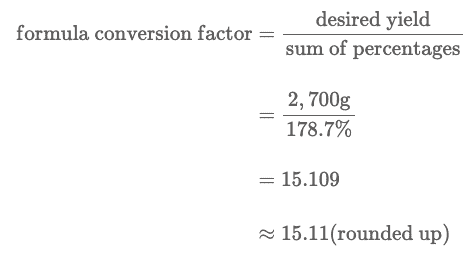
3. Round up the result and multiply it by percentages
| New Weight | Ingredient | Baker’s Percentage |
|---|---|---|
| 15.11 x 80 = 1208.8g | High protein bread flour, malted | 80.00% |
| 15.11 x 20 = 302.2g | Whole wheat flour | 20.00% |
| 15.11 x 76 = 1148.4g | Water | 76.00% |
| 15.11 x 1.9 = 28.7g | Salt | 1.90% |
| 15.11 x 0.8 = 12.1g | Sourdough starter | 0.80% |
There you have it, my Simple Weekday Sourdough recipe scaled up to make three 900g loaves for a total yield of 2,700g. Notice it adds up to a bit more than 2,700g. That’s because we rounded up the formula conversion factor—as Jeffrey says, it’s better to have a little more dough than not enough.
Also, notice the percentages of each ingredient remain the same. We’re scaling everything up proportionally to the new desired yield—thank you, baker’s percentages!
How To Bake Only a Single Loaf of Bread (Even if The Recipe Makes Two)
A bread formula (recipe) for a loaf of bread can be doubled to make four loaves or halved to only make a single loaf. To make only a single loaf, halve all the ingredients in the recipe, even the levain.
Let’s look at an example and continue with my Simple Weekday Sourdough and halve the recipe to make a single 900-gram loaf. All you do is take every ingredient and divide the weight of that ingredient by 2—including the levain build. The percentages will all stay the same, but the weights will be cut in half. So the total formula table will now be:
| Weight | Ingredient | Baker’s Percentage |
|---|---|---|
| 402.9g | High protein bread flour, malted | 80.00% |
| 100.7g | Whole wheat flour | 20.00% |
| 382.8g | Water | 76.00% |
| 9.6g | Salt | 1.90% |
| 4.0g | Sourdough starter | 0.80% |
To double a recipe, do the reverse: take the weight of each ingredient and multiply it by 2. Again, the percentages will remain the same but the total yield will now be 3,600g.
How to Modify a Bread Formula
Next, let’s say we wanted to add some walnuts to the Simple Weekday recipe. Where would we begin? We might instinctively say 15% would be a good amount: not too much, but just enough to get the flavor across[footnote]Your feeling for these percentages will develop with your ever-increased baking experience.[/footnote]. And the beautiful thing about baker’s percentages is we can add the 15% walnuts to the recipe, and all the other ingredient percentages will remain the same. If we kept our final yield at 1,800g, their weights would decrease, but their percentages will stay the same.
And this is important: because we’re keeping the percentages the same, their relative effect on the dough will remain the same.
Now let’s look at the result. This is the ingredient list before:
| Weight | Ingredient | Baker’s Percentage |
|---|---|---|
| 805.8g | High protein bread flour, malted | 80.00% |
| 201.5g | Whole wheat flour | 20.00% |
| 765.5g | Water | 76.00% |
| 19.1g | Salt | 1.90% |
| 8.1g | Sourdough starter | 0.80% |
| – | – | – |
And this is the ingredient list after adding in the walnuts (last row):
| Weight | Ingredient | Baker’s Percentage |
|---|---|---|
| 743.4g | High protein bread flour, malted | 80.00% |
| 185.9g | Whole wheat flour | 20.00% |
| 706.2g | Water | 76.00% |
| 17.7g | Salt | 1.90% |
| 7.4g | Sourdough starter | 0.80% |
| 139.4 | Walnuts, shelled and toasted | 15% |
After adding 15% walnuts to the formula at right, the weights of all the other ingredients went down proportionally, but their percentages remained the same. This means the ingredients’ weights went down by the same amount across the board, giving “room” to add the walnuts to the recipe and still maintain a yield of 1,800g.
Baker’s percentages let us focus on a single ingredient and not worry about how it affects others in the formula.
Imagine for a minute what would happen if we added some walnuts to the recipe but didn’t have baker’s percentages. We’d have to blindly guess their weight and add the walnuts, this would mean our total yield would increase and we’d have an increased dough weight in the end — perhaps our dough wouldn’t fit in our desired proofing baskets or we wouldn’t be able to fit it in our oven.
With baker’s percentages, we can add any percentage of walnuts we desire, and the ratio of other ingredients will remain constant. This lets us focus on just the ingredient we’re increasing (or decreasing) and let the rest of the ingredients still play their role.
Use Spreadsheets To Do All The Work
Understanding baker’s percentages and math is highly valuable, but I depend on my spreadsheets to handle the calculations. Join the baking community here—The Baker’s Corner—and access my baking spreadsheets, which simplify creating and adjusting bread formulas. Essentially, the spreadsheets take care of the hard work and let you focus on baking!
How To Calculate The Prefermented Flour Percentage
Another common term is the prefermented flour (PFF) percentage. This is the percentage of flour that’s fermented ahead of time before the main dough is mixed. This percentage can vary widely depending on the recipe (and whether you’re using only sourdough, instant yeast, a mixture), all the way down to 1%, and up to 50% — and even outside those extents.
Continuing with my Simple Weekday Sourdough example from above, that recipe has a prefermented flour percentage of 8.00% (listed in the Vitals table). This means that 8% of the total flour in the recipe is in the preferment (levain); let’s see how:
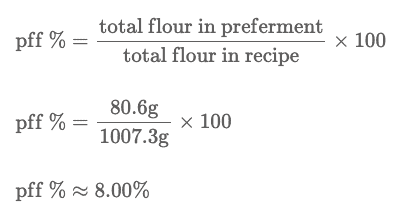
Over time, this percentage will begin to convey something instinctively to you, much like the hydration percentage. You’ll see 5% or 10% or 25% and think, ok, that’s a recipe’s low, medium, or high PFF percentage. Based on this intuitive assessment, you’ll need to pay attention and make a larger sourdough starter to build the levain (if high PFF), or perhaps start with the assumption that the dough will move very slowly for a long fermentation time (if low PFF).
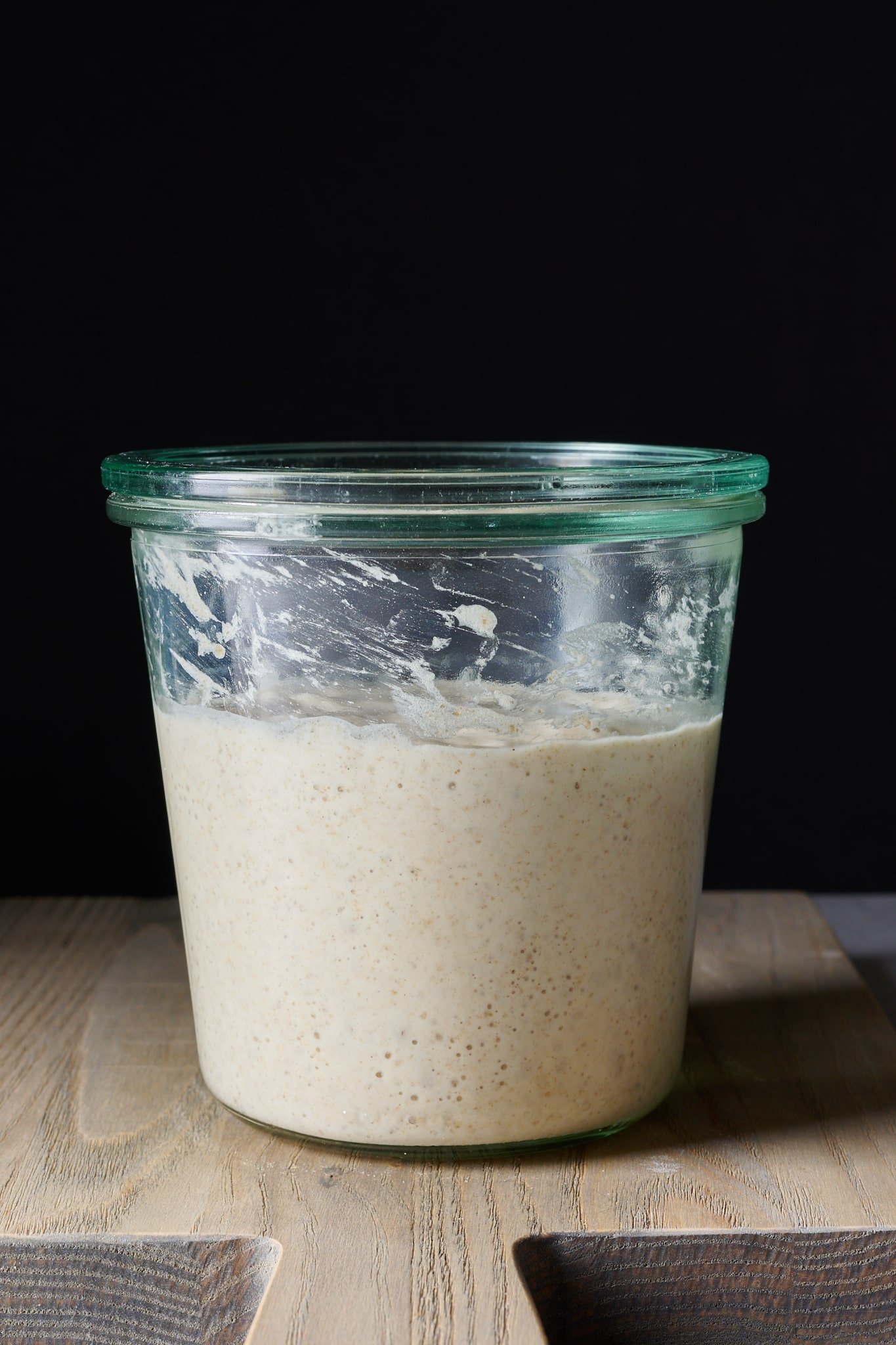
Why Don’t You Include the Sourdough Starter In The Calculations?
This is an important point and something I’ve struggled with here at The Perfect Loaf (and in my baking in general) for years: should I include the sourdough starter flour and water in my overall calculations? For a formula to be wholly correct and account for all flour and water, the flour and water in the starter should be included. However, I typically do not include them for clarity and ease of use. Instead, I treat the starter as a single, cohesive unit.
I see this as a tradeoff between complete correctness and clarity. For example, if I included my starter in my formulas here, you’d always see rye flour as an ingredient (because it’s in a tiny percentage of my sourdough starter feeds). Including that bit of flour would be the correct thing, but it means strange percentages for all the other ingredients, which will lead to questions and confusion.
In the end—and maybe just for now!—I’ve settled on not including the starter flour and water in my calculations. This is because, in many of my formulas, my starter is included in such a small percentage that the impact of that flour and water on the total formula is minimal.
If you’re a TPL Member, you’ll notice in my baking spreadsheets that I offer the option to include your sourdough starter in the calculations for a dough formula if you wish to be 100% correct.
Explaining The Perfect Loaf Bread Tables and Charts
I know there are many tables on this website, but I think it is the most concise and clear way to convey a bread formula. Here at The Perfect Loaf, I like to split up a bread formula into four tables: Vitals, Total Formula, Levain Build, and Dough Mix.
The Vitals table (see right) is a roll-up of all the important aspects of a recipe:
- the total dough weight (how much the recipe makes)
- the prefermented flour percentage (the amount of preferment in the recipe with respect to the total flour in the recipe, more on this below)
- the hydration percentage (the amount of water in the recipe with respect to the total flour in the recipe)
- the yield (how many loaves, buns, rolls, etc., the recipe makes).
Simple Weekday Sourdough Vitals
| Total Dough Weight | 1,800 grams |
| Pre-fermented Flour | 8.00% |
| Hydration | 76.00% |
| Yield | 2 x 900g loaves |
The Total Formula table (see earlier in this post) is a snapshot of the entire formula, taking the levain into account: the total flour required, the total liquid, total fats, total sugars, and so on. In addition, the TF table also shows the baker’s percentages for everything so you can get a sense of the recipe outright (as I discussed at the beginning of this post).
The Levain Build table (see earlier in this post) is what you need to mix to make the levain—the off-shoot of your sourdough starter (see my post here on the differences between a sourdough starter and levain) for a single bake—for the recipe. The levain is usually some percentage of sourdough starter, some flour, and some water that’s made some number of hours before the rest of the recipe begins.
Finally, the Dough Mix table is what you need when you get to your counter and start combining ingredients. This table doesn’t have baker’s percentages because, at this point, you just need the weights of everything to know what to add to your mixing bowl.
Why Are the Ingredient Weights Here Rarely Round Numbers?
You might have already figured out the answer to this by now, but it’s worth stating: almost every one of the recipes you see here will have strange ingredient weights that aren’t usually round numbers. For example, in the Simple Weekend recipe used above the high protein bread flour is 805.8g, not 800g. Why?
When making a formula, I work on the overall baker’s percentages. So, I might say to myself, “I want this recipe to have 80% bread flour, 20% whole wheat flour, 76% water, …” Forming an image of the end loaf in my mind through numbers. And this goes back to that instinctual feel for percentages and how they will eventually translate into bread dough.
In essence, I know for me a 76% hydration dough is low to moderate hydration, and it’s also a manageable dough for many. Finally, when I use those percentages and set the total dough yield to be 1,800g (to make two beautiful boules), the math spits out the actual weights I need for each ingredient to satisfy the percentage concerning the total yield. And because I’m focusing on working in percentages (usually round), the actual weights can be whatever the math says they should be—and generally not round.
What’s Next?
And there you have it, my (hopefully clear and not too scary) introduction to baker’s percentages. If things are still unclear, or I’ve missed something here, please comment below, and I’ll get back to you with an explanation. I’d also love to hear if you have any tricks or suggestions on how you work in baker’s percentages (besides just using a spreadsheet!)—there’s always more to learn and, dare I say, more fun!
If you’re looking for more technical aspects of baking, check out my post on dough temperature and its importance in baking.
Happy baking!


